
Another Preliminary Injunction in OMB Memorandum (M-25-13) Litigation
03.12.2025 | Linda J. Rosenthal, JD

In 2013, internet giant PayPal, Inc. created a “new platform … to make it easier for customers to donate money to their favorite tax-exempt charities.” At the same time, the firm established a 501(c)(3) called PayPal Giving Fund (PPGF) “to process and distribute those donations.” Donors were supposed to be able to make contributions online and select a charity” that would “ultimately receive the benefit of their contribution.
There is an undeniable trend in recent reports on year-to-year charitable giving: Online donations have grown rapidly. For instance, the jump in 2017 was 23%, following a 15% increase in 2016. According to the latest Blackgaud Institute Index for 2019, “online giving grew 6.8% year-over-year and 8.7% of total fundraising came from online giving. This is on track with larger online trends, including e-commerce sales.”
This trend is changing the game for charitable fundraising. See, for example, The End of the Beginning of Online Giving (March 4, 2019) by Blackbaud’s Vice-President of Data & Analytics, Steve MacLaughlin. Online firms like PayPal, Inc. have established a presence in various forms to take advantage of the internet’s role in encouraging and facilitating contributions to worthy charities.
In Class Action Lawsuit Against PayPal Giving Fund (June 8, 2017), we reported about litigation alleging that – though PayPal Giving Fund is “an admirable endeavor” – donations were not always getting to the designated charitable recipients, particularly if the chosen organizations had not already registered with PPGF and signed up for a PayPal business account.
Now, 2-½ years later, there is a major settlement of the case, signed off on by almost half of the state attorneys general around the United States.
PayPal Giving Fund describes itself on its Form 990 as a nonprofit “operated for the benefit of the nonprofit sector” by helping charities raise “new, unrestricted funds.” It “raises awareness and support for nonprofits, primarily through the eBay marketplaces and PayPal.” Sellers on eBay can give all or a portion of sale proceeds, buyers can add a donation to purchases, and PayPal users can “simply make a donation to one of more than 29,000 participating organizations ….”
Kelly Phillips Erb, Forbes Senior Contributor explains in a March 2017 article, Lawsuit Against PayPal Alleges Charities Never Received Donations, that several plaintiffs had recently filed a federal lawsuit in the Northern District of Illinois. Among the most significant allegations in their 36-page complaint is that “a number of the charities never even knew that the platform existed.” Generally, “neither PayPal nor PayPal Giving Fund notifies the unregistered charities that a donation has been made to them or that they need to create an account to receive the money.” In addition, notwithstanding promises and representations that the donations would be given to a donor’s selected charity, “no effort is made to notify the customer that their chosen charity does not have the necessary accounts to be able to receive the funds and that the funds will not be delivered as promised.”
In Class Action Suit Filed against PayPal’s Giving Platform (March 1, 2017), Michael Wyland of The Nonprofit Quarterly provides further detail, including the raising of “… the thorny issue of how much of a donor’s gift actually gets to the intended charity. PayPal promised not only that 100 percent of donations would go to the charity of the donor’s choice but, ‘in email solicitations, [also] to add one percent to each donation.’” Apparently, that was not the case, according to PPGF’s publicly available 2015 Form 990.
Mr. Wyland also emphasized the significance of this case. Plaintiffs were asking for – and eventually received – class-action status “on behalf of all charities and all donors to charities that were misled and/or harmed by PayPal’s actions as well as those of the Washington, D.C.–based PayPal Charitable Giving Fund.”
PayPal Giving Fund denied the allegations but, in January 2020, there was news that almost two dozen states “entered into a multi-state settlement agreement with this charitable arm of PayPal, Inc. The goal of this action by state charity regulators is to make sure that future donors are armed with enough and complete information “to make informed decisions” about participating in the PPGF program and giving platform.
In PayPal Giving Fund Enters Multi-State Settlement to Ensure Transparency to Donors (January 16, 2020), Karen I. Wu, Esq. of Perlman+Perlman explains key areas of concern by these officials. Most particularly, they focused on “PPGF’s disclosure and grantee vetting practices” including findings that –
They also had problems with how long it took PayPal Giving Fund to transfer the donations to the intended charity-recipients and noted that “while PPGF does not collect fees from donors or charities for this service, charities receive contributions more quickly if they maintain a PayPal account, a fact that the regulators claim had not been adequately disclosed.”
As part of the settlement, Paypal Giving Fund agreed to certain reforms that “focus on modifying the disclosures to ensure that donors know the full and complete facts about this program and its procedures. They committed to making “… many of these disclosures ‘unavoidable and prominent,’ which means that ‘the information is not included in an optional pop-up window or on another page accessed by a link on the original page.’”
PPGF also agreed to tell donors when a donation is redirected to another organization. This reform may “… set a new industry-leading standard of transparency among online platforms that utilize an intermediary charity to facilitate donations to various causes.”
Conclusion
According to Ms. Wu, “… state charity regulators’ concerns regarding transparency by online fundraising platforms are not new.” For instance, the National Association of State Charity Officials (“NASCO”) previously posted tips on internet and social media fundraising. And, in 2016, NASCO formed a Crowdfunding Working Group for state charity regulators to “learn from each other how the states handle issues relating to fundraising via third party websites and social media.”
